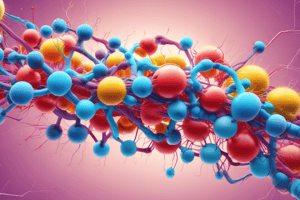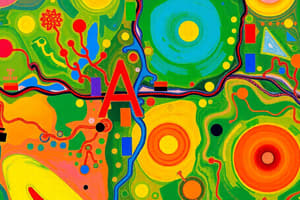Podcast
Questions and Answers
What is the final electron acceptor in aerobic respiration?
What is the final electron acceptor in aerobic respiration?
- Hydrogen (H2)
- Oxygen (O2) (correct)
- Nitrate (NO3-)
- Sulfur (S)
Which type of protein complex is NOT one of the main carriers in the electron transport system?
Which type of protein complex is NOT one of the main carriers in the electron transport system?
- Iron-sulfur proteins
- Lipoproteins (correct)
- Quinones
- Cytochromes
How do electrons move within the electron transport system (ETS)?
How do electrons move within the electron transport system (ETS)?
- From lower to higher redox potential
- Only through mobile electron carriers
- From higher to lower redox potential (correct)
- Randomly, with no specific order
What key process is powered by the proton motive force (PMF)?
What key process is powered by the proton motive force (PMF)?
Which of the following can bacteria like E. coli use when oxygen levels are low?
Which of the following can bacteria like E. coli use when oxygen levels are low?
What happens to the electrons as they are transferred through the electron transport system?
What happens to the electrons as they are transferred through the electron transport system?
What is the role of ATP synthase in cellular respiration?
What is the role of ATP synthase in cellular respiration?
Which of the following describes the electrochemical gradient created by hydrogen ion (H+) pumping?
Which of the following describes the electrochemical gradient created by hydrogen ion (H+) pumping?
Flashcards are hidden until you start studying
Study Notes
Electron Transport System (ETS)
- Final step in cellular respiration, involving protein complexes and mobile electron carriers.
- Electrons from NADH and FADH2 transfer through ETS, resembling a bucket brigade mechanism.
- Electrons transition from carriers with lower redox potential to those with higher potential.
- Four main types of electron carriers:
- Cytochromes
- Flavoproteins
- Iron-sulfur proteins
- Quinones
Aerobic Respiration
- Oxygen (O2) is the final electron acceptor, reducing to water (H2O).
- Cytochrome oxidase is the last electron carrier, differs among bacteria and aids in identification (e.g., Pseudomonas aeruginosa vs. Vibrio cholerae).
Conditions for Alternative Respiration
- Aerobic respiration may be limited by:
- Absence of genes for specific cytochrome oxidases.
- Lack of mechanisms to handle harmful oxygen radicals like hydrogen peroxide.
- Insufficient oxygen availability.
- Alternative pathways involve anaerobic respiration using inorganic molecules as electron acceptors.
- Denitrifiers reduce nitrate (NO3-) and nitrite (NO2-) to nitrogen gas (N2).
- Some bacteria, such as E. coli, can switch to nitrate usage when oxygen is scarce.
Energy Dynamics in Electron Transfer
- Electrons lose energy during their transfer in the electron transport system (ETS).
- Some of the released energy is utilized to pump hydrogen ions (H+) across membranes.
Hydrogen Ion Pumping
- In prokaryotic cells, H+ is pumped outside the cytoplasmic membrane into the periplasmic space.
- In eukaryotic cells, H+ is pumped from the mitochondrial matrix to the intermembrane space.
Electrochemical Gradient
- An uneven distribution of H+ creates an electrochemical gradient.
- Higher H+ concentration leads to a proton motive force (PMF) and makes the side with more H+ more acidic.
Uses of Proton Motive Force (PMF)
- PMF facilitates ATP synthesis and powers processes like nutrient transport and flagella movement.
Chemiosmosis
- H+ diffuse across membranes through channels in ATP synthase, likened to water flowing through a dam.
- ATP synthase functions as a generator, turning as H+ flows through it.
ATP Synthase Function
- H+ movement leads to ATP regeneration from ADP and inorganic phosphate (Pi) via oxidative phosphorylation.
- In prokaryotes, H+ moves into the cytoplasm; in eukaryotes, H+ flows into the mitochondrial matrix.
Studying That Suits You
Use AI to generate personalized quizzes and flashcards to suit your learning preferences.




